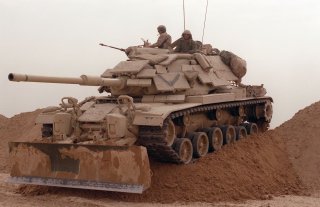This Old Tank Helped Crush Saddam Hussein (It Was Meant to Crush Russia)
An impressive record for an aging weapon.
Key Point: These tanks were a stopgap before the introduction of the M1 Abrams. But when called for duty, they did their job and rushed Saddam's forces.
Though originally designed in the 1950s, the M60 was used in the Gulf War by the Marine Corps—and destroyed hundreds of Iraqi tanks.
Main Battle Tank
The M60 was intended to be the United States’ first Main Battle Tank, which could meet operational requirements at both the tactical and strategic level. The MBT concept was designed to combine the firepower of a heavy tank with the mobility of what was then termed a medium tank. The MBT doctrine required high mobility, good armor, and adequate firepower.
The M60 was given a 105 millimeter main gun, a significant upgrade from the preceding M48’s 90 millimeter gun (though later M48s were also equipped with a 105 millimeter gun as well).
The original M60 was quickly designed and produced as an emergency fix. At the time, in the late 1950s and early 1960s, the United States saw Soviet tank advancements—particularly the T-54/55 family—as overshadowing American armor capabilities. Initial production M60s were rushed to West Germany and to South Korea.
The M60 was intended to use new composite armor made of silica glass that could better withstand hits than standard all-steel rolled homogenous armor. While the armor panelling was better able to resist initial hits than steel, the paneling became severely degraded and secondary hits easily penetrated the armoring. Designers therefore still opted for an all-steel construction, making the M60 the last American tank to be protected by all-steel armor.
Before the introduction of the M1 Abrams tank in the early 1980s, the United States’ M60s were upgraded to the A3 standard. Turret armor thickness was increased, and flammable hydraulic fluid in the turret was exchanged for a non-flammable alternative. After the full introduction of the M1 Abrams, a large number of surplus American M60 tanks of various builds were sold to American allies in the Middle East.
Gulf War
In combat with the United States, M60s were lethal. During the 1991 Gulf War, heavily upgraded Marine M60s lead the push towards Kuwait International Airport and devastated Iraqi armor. During the tank battle—the largest in Marine Corps history—hundreds of Iraqi T-55s and T-62s were destroyed, including a high number of the then-dominant Soviet-designed T-72s as well as a number of armored personnel carriers and trucks.
After the Gulf War, the M60A3s in Marine Corps service were exchanged for M1A1 Abrams tanks and officially retired from U.S. service.
Israeli & Turkish M60s
Israel received a number of M60 tanks from the Untied States that saw combat in the 1982 Lebanon War. These Israeli tanks, dubbed Magach, were outfitted with explosive-reactive armor (ERA) to better protect against anti-tank missiles that had devastated Israeli armor during the 1972 Yom Kippur War. The Magachs were also outfitted with improved tracks to better handle rocky terrain and a thermal sleeve for the main gun, which improved accuracy during extended firing.
Israel sold an upgrade package to Turkey in 2002, delivering upgraded M60s in the mid-2000s based on their own Magach tanks. The Turkish M60s, called Sabra, have an updated 120 millimeter main gun, explosive-reactive armor, and the sturdy treads from Israel’s Merkava main battle tank.
Legacy
The M60 had a very long run for the United States’ first main battle tank—all-steel no less. Though upgraded several times during its service life, probably the most important part of a tank is its crew. It appears that the M60 had excellent crews.
Caleb Larson holds a Master of Public Policy degree from the Willy Brandt School of Public Policy. He lives in Berlin and writes on U.S. and Russian foreign and defense policy, German politics, and culture.
This first appeared in 2020 and is being reposted due to reader interest.
Image: Wikimedia
More From The National Interest:
Russia Has Missing Nuclear Weapons Sitting on the Ocean Floor

